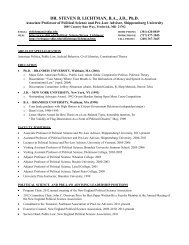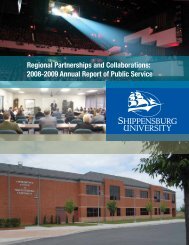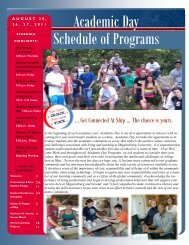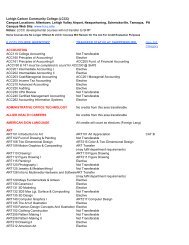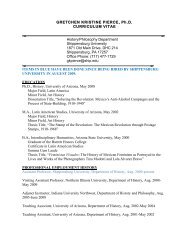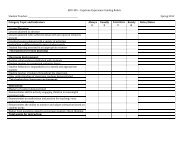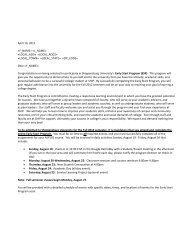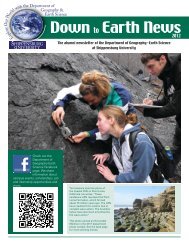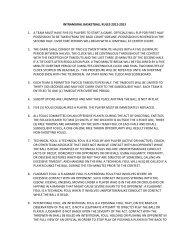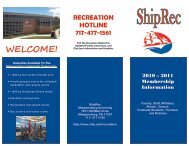Complete Issue - Shippensburg University
Complete Issue - Shippensburg University
Complete Issue - Shippensburg University
- No tags were found...
Create successful ePaper yourself
Turn your PDF publications into a flip-book with our unique Google optimized e-Paper software.
14 PROTEUS: A Journal of IdeasLandscape irrigation contributes to most of southernNevada’s consumptive water use (Sovocool et al. 2006)which prompted the Southern Nevada Water Authority(SNWA), a regional collaborative of seven public waterand waste water agencies, to craft strategies aimed atconserving water in the residential landscape.The SNWA showed single family residencies withxeric landscapes use 76 percent less water than thosewith turf-dominated landscapes. Xeric landscapes werecomposed of desert-adapted shrubs, trees, ornamentalgrasses, and crushed rock mulch (Sovocool et al. 2006).Total water use of households with xeric landscapesaveraged 96,000 gallons less than homes with turf-typelandscapes. Using xeric landscapes might be one way toconserve water in the urban environment.While xeric landscapes are likely to flourish inNevada because of their documented water conservationbenefits, the use of xeric landscapes as a waterconservation measure could influence urban landscapingin other regions of the United States. For example,the increasing frequency of summer droughts in partsof the United States, such as the Northeast, that areunaccustomed to droughts (Wolfe et al. 2008), willplace increasing demand for landscape irrigation andlandscapes that conserve water. Additionally, expectedincreases in the earth’s average temperature will increaseevapotranspiration which could exacerbate droughtconditions (NDRC 2008). Higher temperatures willincrease evaporation from outdoor water features andelevate evapotranspiration from plants. Both of thoseoccurrences will augment the demand for water inurban landscapesBefore xeric landscapes can be widely adopted,barriers to their adoption must be conquered. One ofthe highest rated barriers to installing xeric landscapesis concern about their aesthetics (Hurd et al. 2006).Consumers may select xeric landscapes as a way toconserve water if those landscapes can offer similarfunctions as traditional landscapes (Spinti et al., 2004).So, landscape designers and planners must incorporatethe same design elements found in traditionallandscapes into xeric landscapes to ensure that xericlandscapes are appealing.As a frontier for water conservation, perhapsthe greatest gain in water conservation in the urbanenvironment will be made by improving the efficiencyof landscape irrigation delivery systems. In the broadestsense, landscape irrigation is the application of waterto land areas that supply the water needs of ornamentaland landscape plants (St. Hilaire et al. 2008). Becauselandscape irrigation involves an engineered physicalsystem that requires user input, skilled installation, andperiodic maintenance, the risk of inefficiency is high. Abreakdown in any one of these items or activities causesreduced irrigation efficiency. So, improving irrigationefficiency must be at the heart of any strategy thatseeks to guarantee the most efficient use of water in theurban landscape.Significant gains in urban landscape irrigationefficiency will be made if landscape water budgetsare developed, irrigations are scheduled correctly, anduser-friendly technology is infused into the landscapeirrigation process. An urban landscape water budget,also known as its maximum applied water allowance,can be calculated to provide a quantitative estimate ofan urban landscape’s water budget (St. Hilaire et al.2008). Residential urban landscapes are heterogenousmixes of turfgrass, woody, and herbaceous plant speciesthat are valued for their aesthetics, not their production.So, crop water budgets, steeped in the concept ofoptimum growth and yield, are not relevant to theurban landscape (Shaw and Pittenger 2004). Ratherthan rely on water budgets calculations that have beendeveloped for crops, urban landscape professionals mustdevelop water budgeting tools that are unique to theurban landscape. Some urban residential landscapescan thrive with less water than is indicated from acalculated water budget. This fact alone offers a uniqueopportunity for water conservation in the urbanlandscape.User-friendly technology, such as smart controllersand soil moisture sensors can remove the decision toirrigate from the hands of the homeowner. Becausemost conventional in-ground irrigation systems areoperated by a controller that mandates operator (homeowner)intervention to adjust the daily or seasonalirrigation run times, most homeowners set the scheduleand do not seasonally adjust their irrigation schedules.This results in an over-irrigated residential landscapeduring periods of reduced plant water demand, such asthe fall to winter period (Davis et al. 2007).Some smart controllers will automatically adjustirrigation schedules based on weather conditions. Soilmoisture sensors can detect levels in soils and terminateirrigation events when soil moisture reaches setlevels. Smart controllers have been reported to reducesummertime applied water by up to 42 gallons per dayfor residential landscapes and up to 545 gallons perday for commercial landscapes (Irvine Ranch WaterDistrict 2008a). The widespread adoption of smartcontroller technology or the use of soil moisture sensorshas the potential to realize significant water savings.Saving water will become a significant piece offuture water management programs for rapidly growingpopulations (California Office of Water Use Efficiency2006) and has implications for how water is used inthe residential landscape. Environmental laws, craftedto limit ecosystem degradation, are constraining thedevelopment of new sources of water for the urbanenvironment (Dickinson 2008). Thus, utilization ofreuse water in the urban landscape is one strategycommunities can use to offset the lack of new watersources. Potential sources of reuse water includeeffluent, storm water runoff, and nursery runoff. Reusewater is more likely to be used to irrigate golf courses,parks, and roadway medians where public acceptance



